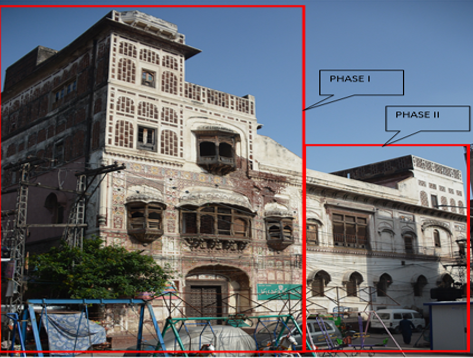Identity of Sikh Architecture in Lahore
Abstract
 Abstract Views: 0
Abstract Views: 0
The current research focused on the “analytical aspects of change in architectural style” of Lahore that took place due to ethnographical, anthropological, and administrative changes brought about by Ranjīt Singh and the shift of architectural identity of Lahore. The study focused on the process of planning and construction of streets and buildings. It also aimed to build a narrative about the shift of architectural identity of the city. Furthermore, it also highlighted the new identity of the city gained during the reign of Mahārāja Ranjīt Singh. Many stories and folklores are linked to the origin of the name “Lahore” as the city was inhabited about 2000 B.C. According to the Hindu tradition, the word “Lahore” is based on the name of Loh, one of the sons of Rāma, the king of Ayūdhiya. Before the Sikh rāj, Lahore was governed by Mughals and was known as the “City of Gardens”. Afterwards, Lahore saw the Sikh period of devastation and extermination. Initially, Sikh sardārs fought for Lahore, looted the city, and then divided it into three parts. Each part was governed by a Sikh sardār. The anarchy of the Sikh period came to a halt with the beginning of Rāja Ranjīt Singh’s reign. He took a keen interest in the administration and construction of the city. Many new ḥavelis and gardens were constructed not only by Ranjīt Singh, however, also by his courtiers.
Downloads
References
References
Baqir, M. (1952). Lahore: Past and present. Punjab University Press.
Chaudhary, N. A. (1998). Lahore, glimpses of a glorious heritage. Sang-e-Meel Publishers.
Chaudhary, N. A. (2000). A short history of lahore and some of its monuments. Sang-e-Meel Publishers.
Creswell, J. W. (2011). Research design: Qualitative, quantitative and mixed methods approaches. Sage Publications.
Ezdi, R. (2009). The dynamics of land use in Lahore inner city: The case of Mochi Gate. Environment and Urbanization, 21(2), 477–500. https://doi.org/10.1177/0956247809342776
Fauq, M. D. (2005). Lahore ahd e mughlia main. Sang-e-Meel Publishers.
Glover, W. J. (2008). Making Lahore modern: Constructing and imagining a colonial city. University of Minnesota Press.
Goulding, H. (2006). Old Lahore: Reminiscences of a resident. Sang-e-Meel Publishers.
Hugel. B. C. (1845). Travels in Kashmir and the Punjab. Containing a particular account of the government and character of the sikhs. John Petheram.
Karamat, S. (2019). Architecture of sikh shrines and gurudawaras in Pakistan. New Line Publishers.
Khan, A. N. (1992). Lahore fort. Department of Archaeology and Museum. https://doam.gov.pk/public/sites/6502
Kipling, J., & Thornton, T. (1860). Lahore as it was. National College of Arts Publications.
Lal, K. (2001). Tarikh-i-Lahore. Sang-e-Meel Publishers.
Latif, S. M. (1994). Lahore, architectural remains and antiquities. Sang-e-Meel Publishers.
Muhammad, S. D. (1962). Sayasi aur saqafati tareekh. Naqoosh.
Munir, M. A. (2018). Mit ta hua Lahore. Atish Fishan Publicaitons.
Rehman, A. (2013). Mapping Lahore, tracing historical geography through maps. Al-Meezan.
Shahzad, G. (2007). Lahore, ghar, galliyan, darwazay. Sang-e-Meel Publishers.
Yunis, A. (1991). Mīra sh̲aihr Lahore. Atish Fishan Publications.

Copyright (c) 2024 Muiz Khalifa Ahmed

This work is licensed under a Creative Commons Attribution 4.0 International License.
JAABE follows an open-access publishing policy and full text of all published articles is available free, immediately upon publication of an issue. The journal’s contents are published and distributed under the terms of the Creative Commons Attribution 4.0 International (CC-BY 4.0) license. Thus, the work submitted to the journal implies that it is original, unpublished work of the authors (neither published previously nor accepted/under consideration for publication elsewhere). On acceptance of a manuscript for publication, a corresponding author on the behalf of all co-authors of the manuscript will sign and submit a completed Copyright and Author Consent Form.
Copyright (c) The Authors





